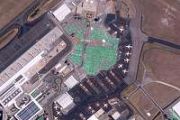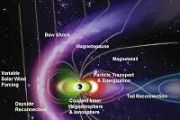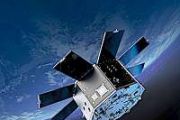
Copernical Team
L3Harris Technologies Launches New Satellites to Enhance US Missile Defense
TelePIX Launches TetraPLEX: The Next-Gen AI Processor Elevating Satellite Data Analysis
 In a significant stride for satellite technology, TelePIX, a South Korean space startup, has unveiled the TetraPLEX, a high-performance AI processor that promises to revolutionize the handling and analysis of satellite data. This processor, developed in collaboration with tech giant NVIDIA, boasts a groundbreaking 10 trillion operations per second, positioning it as a cornerstone for advanced in
In a significant stride for satellite technology, TelePIX, a South Korean space startup, has unveiled the TetraPLEX, a high-performance AI processor that promises to revolutionize the handling and analysis of satellite data. This processor, developed in collaboration with tech giant NVIDIA, boasts a groundbreaking 10 trillion operations per second, positioning it as a cornerstone for advanced in Solar Orbiter Captures Intense Activity as Sun Approaches Cycle Peak
 As the Sun inches closer to the apex of its magnetic activity cycle, the European Space Agency's Solar Orbiter has provided unprecedented snapshots highlighting a significant uptick in solar phenomena. These include more frequent and intense solar explosions, darkly spotted regions indicating sunspots, looping plasma formations, and turbulent swirls of super-heated gas. The observations mark a s
As the Sun inches closer to the apex of its magnetic activity cycle, the European Space Agency's Solar Orbiter has provided unprecedented snapshots highlighting a significant uptick in solar phenomena. These include more frequent and intense solar explosions, darkly spotted regions indicating sunspots, looping plasma formations, and turbulent swirls of super-heated gas. The observations mark a s Magnetars at the Heart of Neutron Star Collisions: A Computational Breakthrough
 In a groundbreaking study, researchers at the Max Planck Institute for Gravitational Physics, alongside colleagues from universities in Kyoto and Toho, have unveiled the enigmatic process powering the immense magnetic fields driving kilonova explosions and gamma-ray bursts resulting from neutron star mergers. This revelation, derived from an unprecedentedly high-resolution computer simulation th
In a groundbreaking study, researchers at the Max Planck Institute for Gravitational Physics, alongside colleagues from universities in Kyoto and Toho, have unveiled the enigmatic process powering the immense magnetic fields driving kilonova explosions and gamma-ray bursts resulting from neutron star mergers. This revelation, derived from an unprecedentedly high-resolution computer simulation th SpeQtral Unveils TarQis: a Mobile Quantum Optical Ground Station (Q-OGS)
 SpeQtral, a frontrunner in the quantum communications arena, recently announced the launch of TarQis, a cutting-edge Mobile Quantum-Optical Ground Station (Q-OGS). This innovative solution is set to democratize access to secure communication via satellite Quantum Key Distribution (QKD), a pivotal move in the realm of cybersecurity. TarQis is engineered to work in harmony with SpeQtral's forthcom
SpeQtral, a frontrunner in the quantum communications arena, recently announced the launch of TarQis, a cutting-edge Mobile Quantum-Optical Ground Station (Q-OGS). This innovative solution is set to democratize access to secure communication via satellite Quantum Key Distribution (QKD), a pivotal move in the realm of cybersecurity. TarQis is engineered to work in harmony with SpeQtral's forthcom Pony Express 2 Mission Ready to Enhance Military Connectivity with Innovative Space Technologies
 Lockheed Martin (NYSE: LMT), a global aerospace, defense, security, and advanced technologies company, has announced that its Pony Express 2 mission is ready for launch. This mission, originating from Littleton, Colorado, is a self-funded technology demonstration designed to enhance Combined Joint All-Domain Command and Control (CJADC2) capabilities through advanced space technologies.
The
Lockheed Martin (NYSE: LMT), a global aerospace, defense, security, and advanced technologies company, has announced that its Pony Express 2 mission is ready for launch. This mission, originating from Littleton, Colorado, is a self-funded technology demonstration designed to enhance Combined Joint All-Domain Command and Control (CJADC2) capabilities through advanced space technologies.
The Rocket Lab Sets Course for Historic In-Space Manufacturing Capsule Return
 In a landmark decision that propels commercial space ventures into a new era, Rocket Lab USA, Inc. (NASDAQ: RKLB), a pioneer in launch and space systems, has received the green light from the Federal Aviation Administration (FAA) for a groundbreaking mission. This approval paves the way for the return of Varda Space Industries' in-space manufacturing capsule, marking the first instance the FAA h
In a landmark decision that propels commercial space ventures into a new era, Rocket Lab USA, Inc. (NASDAQ: RKLB), a pioneer in launch and space systems, has received the green light from the Federal Aviation Administration (FAA) for a groundbreaking mission. This approval paves the way for the return of Varda Space Industries' in-space manufacturing capsule, marking the first instance the FAA h White House confirms Russia developing 'anti-satellite' technology
 The White House confirmed Thursday Russia is developing "anti-satellite capability" but does not currently present an immediate threat.
National Security Council spokesperson John Kirby told reporters the new development is not an active capability currently being deployed, and "though Russia's pursuit of this particular capability is troubling, there is no immediate threat to anyone's
The White House confirmed Thursday Russia is developing "anti-satellite capability" but does not currently present an immediate threat.
National Security Council spokesperson John Kirby told reporters the new development is not an active capability currently being deployed, and "though Russia's pursuit of this particular capability is troubling, there is no immediate threat to anyone's Week in images: 12-16 February 2024

Week in images: 12-16 February 2024
Discover our week through the lens
Revolutionary hybrid space network architecture showcased in landmark demonstration
 In a significant step toward achieving a unified global communications network, Aalyria, in collaboration with the U.S. Government, the European Space Agency (ESA), and other partners, recently showcased a pioneering technology demonstration. This event, centered around the Hybrid Space Architecture (HSA) and Combined Joint All-Domain Command and Control (CJADC2) concepts, marked a pivotal momen
In a significant step toward achieving a unified global communications network, Aalyria, in collaboration with the U.S. Government, the European Space Agency (ESA), and other partners, recently showcased a pioneering technology demonstration. This event, centered around the Hybrid Space Architecture (HSA) and Combined Joint All-Domain Command and Control (CJADC2) concepts, marked a pivotal momen 
































